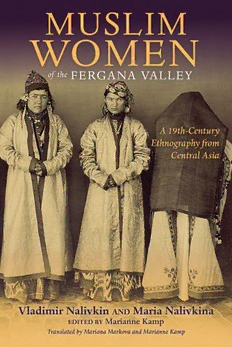
Muslim Women of the Fergana Valley: A 19th-Century Ethnography from Central Asia PDF
Preview Muslim Women of the Fergana Valley: A 19th-Century Ethnography from Central Asia
MUSLIM WOMEN of the FERGANA VALLEY This page intentionally left blank MUSLIM WOMEN of the FERGANA VALLEY A 19th-Century Ethnography from Central Asia Vladimir Nalivkin and Maria Nalivkina Edited by Marianne Kamp Translated by Mariana Markova and Marianne Kamp Indiana University Press Bloomington and Indianapolis This book is a publication of Indiana University Press Office of Scholarly Publishing Herman B Wells Library 350 1320 East 10th Street Bloomington, Indiana 47405 USA iupress.indiana.edu English translation © 2016 by Marianne Kamp and Mariana Markova All rights reserved No part of this book may be reproduced or utilized in any form or by any means, electronic or mechanical, including photocopying and recording, or by any information storage and retrieval system, without permission in writing from the publisher. The Association of American University Presses’ Resolution on Permissions consti- tutes the only exception to this prohibition. ∞ The paper used in this publication meets the minimum requirements of the American National Standard for Information Sciences—Permanence of Paper for Printed Library Materials, ANSI Z39.48-1992. Manufactured in the United States of America Cataloging information is available from the Library of Congress. ISBN 978-0-253-02127-4 (cloth) ISBN 978-0-253-02138-0 (paperback) ISBN 978-0-253-02149-6 (ebook) 1 2 3 4 5 21 20 19 18 17 16 Contents Editor’s Introduction | Marianne Kamp 1 Authors’ Preface: A Sketch of the Everyday Life of Women of the Sedentary Native Population of the Fergana Valley | Vladimir Nalivkin and Maria Nalivkina 29 1 A Short Sketch of the Fergana Valley 31 2 Religion and Clergy 57 3 Houses and Utensils 79 4 Woman’s Appearance and Her Clothing 89 5 Occupations and Food 103 6 The Woman, Her Character, Habits, Knowledge, and Behavior toward the People around Her 120 7 Pregnancy and Childbirth: A Girl 142 8 The Maiden: Marriage Proposal and Marriage 158 9 Polygyny, Divorce, Widowhood, and Death of a Woman 175 10 Prostitution 185 Glossary 191 Notes 201 Bibliography 221 Index 227 Caspian Approximate borders of the Russian Empire Sea in Central Asia, late 19th century Borders of the Khanate of Khiva and Emirate of Bukhara Rivers Aral Sea RRUUSSSSIIAANN Khanate EEMMPPIIRREE of Khiva Urgench Khiva Syr D arya Darya Emoirf ate mu Bukhara A Tashkent Pishpek Bukhara (Toshkent) (Bishkek) PPEERRSSIIAA (Buxoro) Jizzax Samarkand Namangan (Samarqand) Andijon Kokand Zarafshon(Qo'qon) Skoblev Naryn AAFFGGHHAANNIISSTTAANN CCHHIINNAA 0 50 100 200 Miles Central Asia, including the extent of Russian conquest, late nineteenth century. Source: Margo Berendsen, 2015. Twenty-first-century international boundaries and country names KKYYRRGGYYZZSSTTAANN KKAAZZAAKKHHSSTTAANN M o u n t a i n s a l h a t k Nanay N a ry n C Tashkent Fergh a n UUZZBBEEKKIISSTTAANN a M o Namangan u n t S a yr Dar F e r g a n a Va l l e y Andijon Kara ins ya Qo’qon Darya Osh TTAAJJIIKKIISSTTAANN Fergana KKYYRRGGYYZZSSTTAANN M o u n t a i n s A l a i T u r k e s t a n Mo untains TTAAJJIIKKIISSTTAANN Fergana Valley with cities mentioned by the Nalivkins and present-day boundaries superimposed. Source: Margo Berendsen, 2015. This page intentionally left blank Editor’s Introduction Marianne Kamp T his work, originally titled A Sketch of the Everyday Life of Women of the Sedentary Native Population of the Fergana Valley and first published in Russian in 1886, offers readers a nineteenth-century ethnography focused on women in an Islamic society, as observed by Maria and Vladimir Nalivkin. The Nalivkins were Russians who lived in a “Sart” (Uzbek) village in a territory new to the Rus- sian Empire, the Fergana Valley. With the exception of Edward G. Lane’s An Account of the Manners and Customs of Modern Egyptians, very few nineteenth- century ethnographies of Muslim societies were based on the ethnographer’s long-term participant observation, and accounts by women were even rarer. Maria Nalivkina learned the Sart language and lived in the village of Nanay from 1878 to 1884, during which she befriended her neighbors and tried to learn all she could about their lives and the ways that Islam shaped their lives. The authors’ focus on explaining Islam will be familiar to those who have studied nineteenth- century Orientalist scholarship: the authors wrote with all the hubris of Western cultural superiority but also with an attention to detail and effort at description that arose from genuine curiosity. The exploration of women’s lives is unique, but the Nalivkins’ focus on everyday life in rural communities exemplifies a domi- nant trend in nineteenth-century Russian ethnography. This introduction provides brief biographies of Vladimir and Maria, focus- ing on their intellectual formation, the milieu within which they worked, and their scholarly production. Comparisons are drawn between their ethnographic work and those of several of their contemporaries in Russian Central Asia. An overview of the book’s themes is followed by a discussion of choices that we made in translation. The Nalivkins In 1878, a young Russian couple, Vladimir Petrovich Nalivkin and Maria Vladi- mirovna Nalivkina, purchased a courtyard home and some land in the kishlak (village) of Nanay in the Fergana Valley. Nanay, situated in the hills between the Tian Shan Mountains to the north and Namangan to the south, was home to people whom the Nalivkins identified as Sarts. I discuss the meaning of this term later. The Nalivkins lived in Nanay for six years, where they learned to speak and
